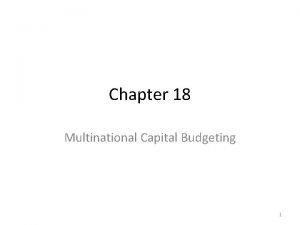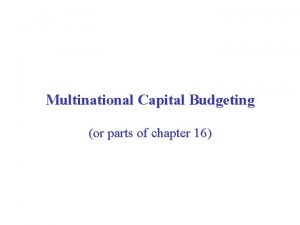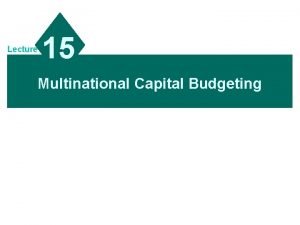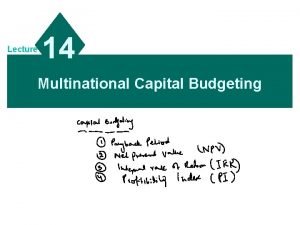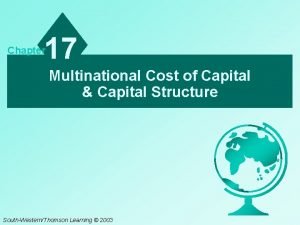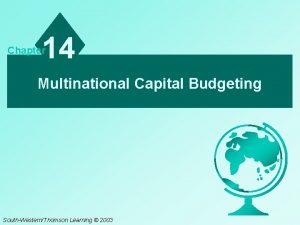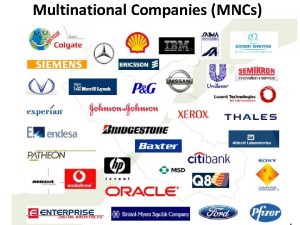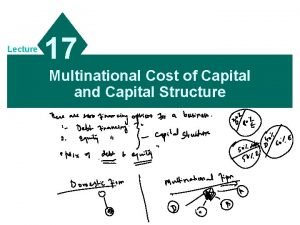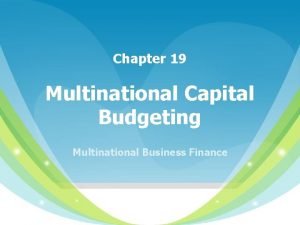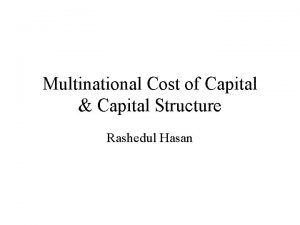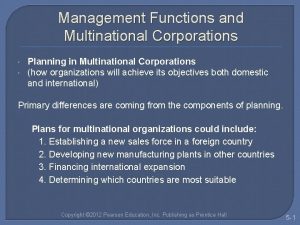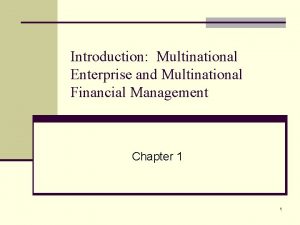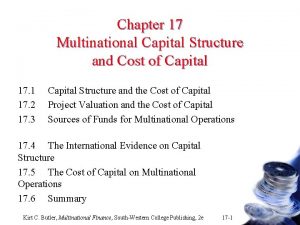Lecture 17 Multinational Cost of Capital and Capital














- Slides: 14

Lecture 17 Multinational Cost of Capital and Capital Structure

Chapter Objectives n To explain how corporate and country characteristics influence an MNC’s cost of capital; n To explain why there are differences in the costs of capital across countries; and n To explain how corporate and country characteristics are considered by an MNC when it establishes its capital structure. 17 - 2

Cost of Capital • A firm’s capital consists of equity (retained earnings and funds obtained by issuing stock) and debt (borrowed funds). • The cost of equity reflects an opportunity cost, while the cost of debt is reflected in the interest expenses. • Firms want a capital structure that will minimize their cost of capital, and hence the required rate of return on projects. 17 - 3

Comparing the Costs of Equity and Debt • A firm’s weighted average cost of capital k c = ( D ) kd ( 1 _ t ) + ( E ) ke D+E where D E kd t ke D+E is the amount of debt of the firm is the equity of the firm is the before-tax cost of its debt is the corporate tax rate is the cost of financing with equity 17 - 4

Cost of Capital Searching for the Appropriate Capital Structure Debt Ratio Interest payments on debt are tax deductible… However, the tradeoff is that the probability of bankruptcy will rise as interest expenses increases. 17 - 5

Factors that Cause the Cost of Capital for MNCs to Differ from That of Domestic Firms Larger size Greater access to international capital markets International diversification Exposure to exchange rate risk Exposure to country risk Preferential treatment from creditors & smaller per unit flotation costs Possible access to lowcost foreign financing Cost of capital Probability of bankruptcy 17 - 6

Cost-of-Equity Comparison Using the CAPM • The capital asset pricing model (CAPM) can be used to assess how the required rates of return of MNCs differ from those of purely domestic firms. • CAPM: ke = Rf + b (Rm – Rf ) where ke = Rf = Rm = b = the required return on a stock risk-free rate of return market return the beta of the stock 17 - 7

Cost-of-Equity Comparison Using the CAPM • A stock’s beta represents the sensitivity of the stock’s returns to market returns, just as a project’s beta represents the sensitivity of the project’s cash flows to market conditions. • The lower a project’s beta, the lower its systematic risk, and the lower its required rate of return, if its unsystematic risk can be diversified away. 17 - 8

Implications of the CAPM for an MNC’s Risk • An MNC that increases its foreign sales may be able to reduce its stock’s beta, and hence reduce the required return. • However, some MNCs consider unsystematic project risk to be important in determining a project’s required return. • Hence, we cannot say whether an MNC will have a lower cost of capital than a purely domestic firm in the same industry. 17 - 9

Cost of Capital Across Countries • The cost of capital can vary across countries, such that: MNCs based in some countries have a competitive advantage over others; MNCs may be able to adjust their international operations and sources of funds to capitalize on the differences; and MNCs based in some countries tend to use a debt-intensive capital structure. 17 - 10

Country Differences in the Cost of Debt • A firm’s cost of debt is determined by: the prevailing risk-free interest rate of the borrowed currency, and the risk premium required by creditors. • The risk-free rate is determined by the interaction of the supply of and demand for funds. It is thus influenced by tax laws, demographics, monetary policies, economic conditions, etc. 17 - 11

Country Differences in the Cost of Debt • The risk premium compensates creditors for the risk that the borrower may default on its payments. • The risk premium is influenced by economic conditions, the relationships between corporations and creditors, government intervention, the degree of financial leverage, etc. 17 - 12

Cost of Debt Across Countries 17 - 13

• Source: Adopted from South. Western/Thomson Learning © 2006 17 - 14
 Multinational cost of capital and capital structure
Multinational cost of capital and capital structure Multinational cost of capital and capital structure
Multinational cost of capital and capital structure What is multinational capital budgeting
What is multinational capital budgeting Penganggaran modal multinasional
Penganggaran modal multinasional Multinational capital budgeting
Multinational capital budgeting Multinational capital budgeting example
Multinational capital budgeting example Objectives of mnc
Objectives of mnc Multinational capital structure
Multinational capital structure Multinational capital budgeting
Multinational capital budgeting 01:640:244 lecture notes - lecture 15: plat, idah, farad
01:640:244 lecture notes - lecture 15: plat, idah, farad Project cost management lecture notes
Project cost management lecture notes Cost accumulation and cost assignment
Cost accumulation and cost assignment Cost accumulation and cost assignment
Cost accumulation and cost assignment Cost pools
Cost pools What is a period cost on the income statement
What is a period cost on the income statement


